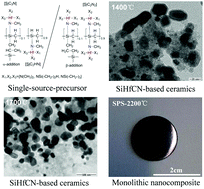Single-source-precursor synthesis of dense SiC/HfCxN1−x-based ultrahigh-temperature ceramic nanocomposites†
Abstract
A novel single-source precursor was synthesized by the reaction of an allyl hydrido polycarbosilane (SMP10) and tetrakis(dimethylamido)hafnium(IV) (TDMAH) for the purpose of preparing dense monolithic SiC/HfCxN1−x-based ultrahigh temperature ceramic nanocomposites. The materials obtained at different stages of the synthesis process were characterized via Fourier transform infrared (FT-IR) as well as nuclear magnetic resonance (NMR) spectroscopy. The polymer-to-ceramic transformation was investigated by means of MAS NMR and FT-IR spectroscopy as well as thermogravimetric analysis (TGA) coupled with in situ mass spectrometry. Moreover, the microstructural evolution of the synthesized SiHfCN-based ceramics annealed at different temperatures ranging from 1300 °C to 1800 °C was characterized by elemental analysis, X-ray diffraction, Raman spectroscopy and transmission electron microscopy (TEM). Based on its high temperature behavior, the amorphous SiHfCN-based ceramic powder was used to prepare monolithic SiC/HfCxN1−x-based nanocomposites using the spark plasma sintering (SPS) technique. The results showed that dense monolithic SiC/HfCxN1−x-based nanocomposites with low open porosity (0.74 vol%) can be prepared successfully from single-source precursors. The average grain size of both HfC0.83N0.17 and SiC phases was found to be less than 100 nm after SPS processing owing to a unique microstructure: HfC0.83N0.17 grains were embedded homogeneously in a β-SiC matrix and encapsulated by in situ formed carbon layers which acted as a diffusion barrier to suppress grain growth. The segregated Hf-carbonitride grains significantly influenced the electrical conductivity of the SPS processed monolithic samples. While Hf-free polymer-derived SiC showed an electrical conductivity of ca. 1.8 S cm−1, the electrical conductivity of the Hf-containing material was analyzed to be ca. 136.2 S cm−1.


 Please wait while we load your content...
Please wait while we load your content...